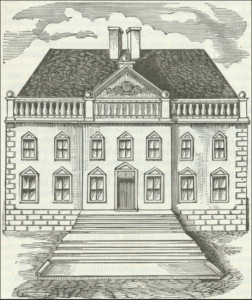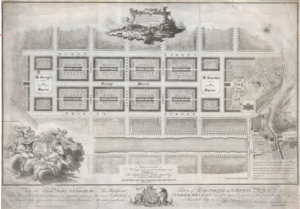 Dr Anthony Lewis tells us about Glaswegian Tobacco Lord properties in Edinburgh
Dr Anthony Lewis tells us about Glaswegian Tobacco Lord properties in Edinburgh
The ownerships of properties in Georgian Edinburgh and Glasgow’s New Towns are rarely discussed yet they can indicate shared legacies connected to colonial plantation economy and slavery.
Looking at Edinburgh’s New Town first, there have been few if any published studies of where property owners and residents came from and still fewer on their businesses or estates. This blog looks at the house Mary Buchanan purchased in George Street in 1787 as an example of New Town properties can be better understood as a built heritage dependent on empire and slavery.
Mary Buchanan was the wife of Alexander Spiers of Elderslie. He headed one of Glasgow’s most prominent transatlantic businesses trading in tobacco. It profited from enslaved African plantation workforces in American colonies such as Virginia. She already knew Speirs through her father, Archibald Buchanan a tobacco merchant who Speirs first represented and then replaced. Another link to Virginia came from her mother, Martha Murdoch. She was the daughter of Lord Provost Peter Murdoch of Rosehill, who traded in sugar. This business also also relied on the British imperial plantation economy and enslaved workforces. For Mary, money derived from slavery was an accepted norm.
By marrying Archibald’s daughter in 1755, Speirs kept his relationship the Buchanan’s family’s financial and political power in Glasgow. This was expressed in property. The family developed a new street it called Virginia Street, and a house at its head called the Virginia Mansion.

Virginia Mansion, Canon Lane, Glasgow (demolished mid 19th century)
Both signified the importance of the colony to the family and city. The mansion came to be owned by Alexander Speirs. The houses in Glasgow’s New Town which Mary Buchanan would have seen nearby properties such as included ones owned by John Glassford of Douglaston’s house or other ‘tobacco lord’ town houses built in the 1750s to 1770s. All these have now gone. But,the legacies of Glaswegians remain in street names such as Ingram, Miller, Buchanan, Glassford, Ingram, Miller and Cochran. Then there are those named after colonies such as Jamaica and Virginia Streets noting their importance to these Glaswegians’ wealth. Today, these street names retain an urban heritage celebrating empire and slavery.
The successful Glaswegian family businesses typically owned many properties: a town house in Glasgow, an urban villa outside the city and perhaps further afield as well as farms, mines and factories. The Virginia Mansion in Glasgow was not the only property Mary lived in. Speirs developed properties and estates in Renfrewshire to make money and kept one for himself he called Elderslie. He died there in 1782. He had made Mary made a trustee of his estate and left her £12,500 (£2.1m in 2021) and properties.
She used her money to purchase her Edinburgh New Town property in 1787. It was a house on the north side of George Street, recently constructed by masons and builders Robert Inglis and John Howden. Glaswegians commonly owned property outside their city. For example, Lady Margaret Mackenzie, third wife of John Glassford, owned a house in Saltcoats in Ayrshire. She and John Glassford used for respite.

Edinburgh New Town Plan, James Craig, 1767 showing George Street
It is not known why Mary Buchanan decided to decorate her George Street house but respite would be unlikely. Society and scale would have been a more likely motivation. It was smaller than both the Virginia Mansion and Elderslie and easier to manage. She already knew Edinburgh New Town society. Just as Glasgow’s New Town accommodated a tightly connected business community of families, this review of Edinburgh New Town’s residential history indicates that she knew other Glaswegians living there. From the 1760s to 1790s eighteen Glaswegian and west of Scotland New Town residents were listed in street directories and duty returns. Seven were women.
Examples include Lady Maxwell, who lived in a flat in Princes Street or Mary Hamilton, widow of Robert Cullen of Parkhead whose brother was Dr William Cullen. He was the physician to Glaswegians including Alexander Speirs, the Buchanan and Glassford families and had been living in Edinburgh for years. Other known men would have included James Colquhoun of Luss at St Andrew’s Square. It was clansman Patrick Colquhoun who was known to Mary because he was a fellow trustee of Alexander Speirs’ estate. Through Patrick she would also have known the Campbells of Blythswood, who also lived in Edinburgh’s New Town. The Campbell’s owned an estate to the west of Glasgow. Here Patrick Colquhoun owned a house he called Kelvingrove.
The fact that Mary wanted to own a property in Edinburgh New Town was indicative of the district’s successful development in the late 1780s and its social reputation. It was a fashionable location and where better to live than in its principal street? The residential history of Georgian Edinburgh New Town has not been widely studied. The Glaswegians there were not a large group. Other groups included people from Aberdeen/Angus, the Scottish Highlands, Ireland, England, the military and East Indian Company. Together they represent many more people who also had links with the British empire.
Mary Buchanan’s New Town house can be seen as an extension of her existing property portfolio and wider social standing. The house indicates the fact that Scottish built heritage need not be thought of as belonging to separate cities but also to property owners. This property was owned by someone whose life was deeply embedded in Scotland and Britain’s imperial plantation economy and whose wealth directly derived from institutional racism and slavery. Mary Buchanan did not live in George Street long. She sold it after a few years. She died in 1818 at Polmont House, a Buchanan family property leaving her estate to her daughters.
Image Attributes:
Image 1:- Courtesy of google.com
Image 2:- Virginia Mansion, Canon Lane (demolished mid 19th century) (Mitchell Library, Glasgow )
Image 3:- Edinburgh New Town Plan, James Craig, 1767 (www.nls.gov)